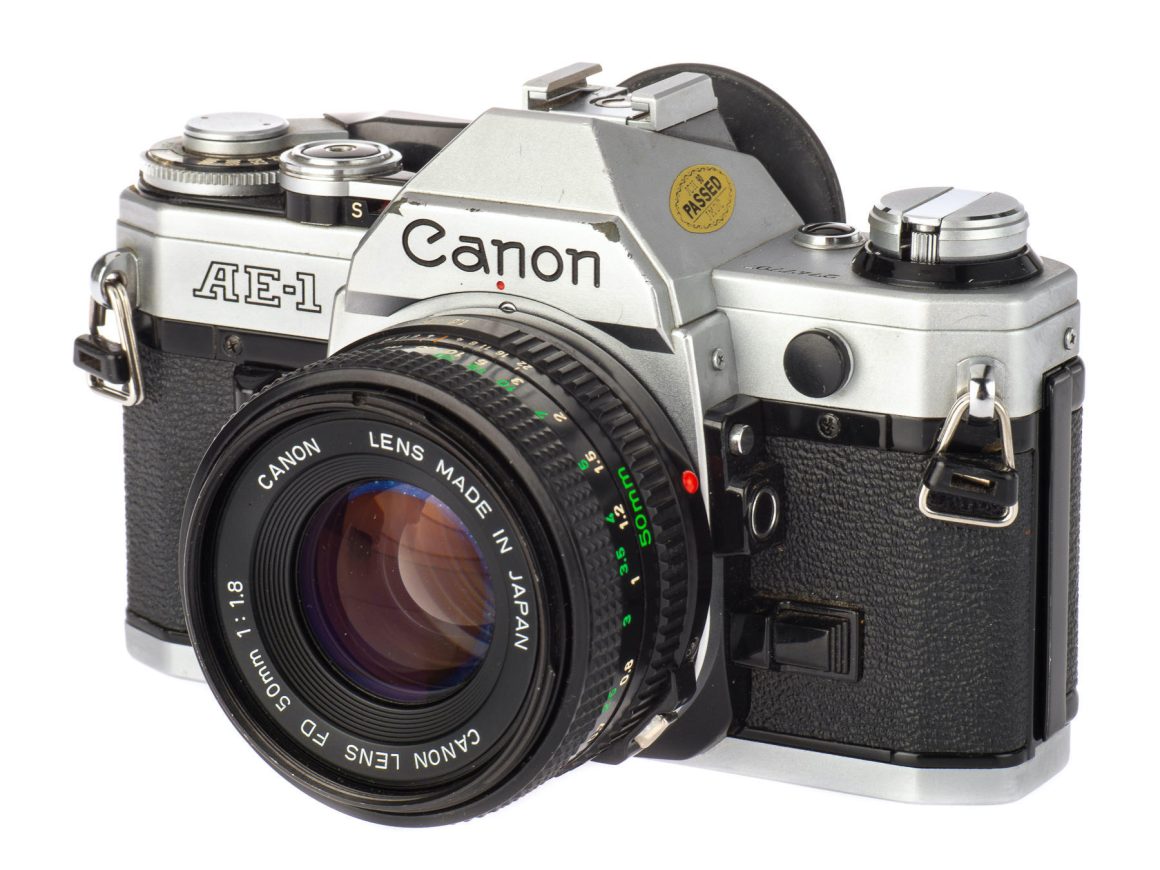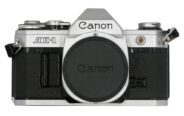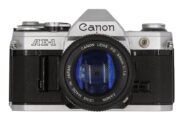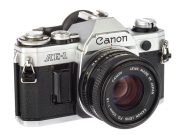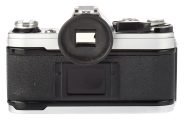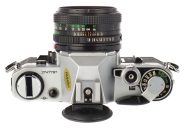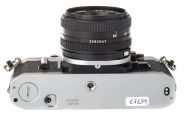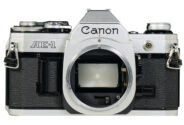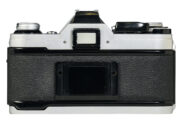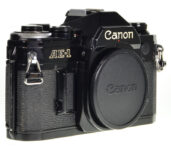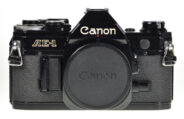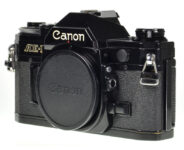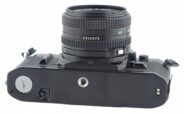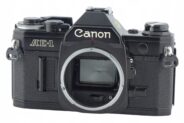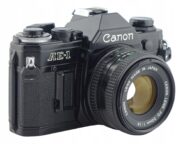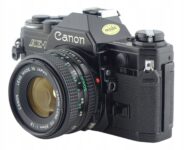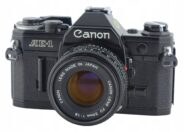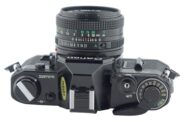Canon AE-1
35mm MF film SLR camera
Specification
| Production details: | |
| Announced: | April 1976 |
| System: | ● Canon FD (1971) |
| Format: | |
| Maximum format: | 35mm full frame |
| Film type: | 135 cartridge-loaded film |
| Mount and Flange focal distance: | Canon FD [42mm] |
| Shutter: | |
| Type: | Focal-plane |
| Model: | Electronically controlled |
| Speeds: | 2 - 1/1000 + B |
| Exposure: | |
| Exposure metering: | Through-the-lens (TTL), open-aperture |
| Exposure modes: | Shutter-priority Auto |
| Manual | |
| Physical characteristics: | |
| Weight: | 590g |
| Dimensions: | 141x87x47.5mm |
Manufacturer description #1
Introduced in April 1976, the AE-1 was a very successful camera worldwide.
When the AE-1 came out, TTL manual-metering models (including the Canon FTb and FTb-N) were still the mainstream in the 35mm SLR market. Autoexposure models were still at the very top end of the SLR market. They were expensive and produced in small numbers.
The AE-1, however, was designed from the ground up with five major units and twenty-five minor units. They were centrally controlled by a microcomputer. By incorporating electronics, the parts count could be reduced by 300. The manufacturing of the camera was also highly automated. This made it possible to produce a low-cost camera having high-end features.
Manufacturer description #2
INSTANT RESPONSE SHUTTER PRIORITY AUTOMATIC EXPOSURE
a. Even someone who's never used a fine camera will take perfect pictures with the automatic AE-1. To get excellent results, just select the proper ASA setting, pick a convenient shutter speed, focus and shoot. The AE-1 picks the right aperture every time.
b. Most experienced photographers prefer shutter-priority automation, since they always know that the shutter speed will be high enough to prevent unwanted camera motion or subject blur.
c. Because of the extremely high reaction speed of the AE-1's silicon photocell, the user is virtually certain to get exposures that are exact, even with rapidly changing lighting situations.
d. A miniaturized "computer" Central Processing Unit (CPU) in the AE-1 handles all signal information in the camera, and makes it respond instantly.
TWO-STEP ELECTROMAGNETIC SHUTTER RELEASE BUTTON
a. One button controls all the camera's automatic functions. When it's depressed partway, it activates the exposure meter whose information is immediately shown in the finder. Full depression "locks in" the AE setting selected by the meter, and triggers the electromagnetic shutter. Because it's an electromagnetic release, it requires significantly less pressure than previous designs of this type. And, because its operation is sequential, it preserves energy from the battery.
EXPOSURE COMPENSATION FOR BACKLIT SITUATIONS
a. In backlit situations, or in the snow or at the beach, a button on the AE-1 conveniently gives an increase of +1.5f-stops when pressed.
b. A special preview lever is also provided for checking depth-of-field.
EASY-TO-READ VIEWFINDER APERTURE DISPLAY
a. The AE aperture setting is clearly displayed in the viewfinder when the shutter button is initially depressed. The aperture scale includes two red warning zones indicating the automatic coupling range limit when using lenses with f/16 or f/22 minimum apertures.
b. A flashing red LED indicator also shows when the lens in use has a slower maximum aperture than that indicated on the scale, so the user must select another shutter speed for proper exposure.
EXCEPTIONAL BATTERY ECONOMY
a. Thanks to unique construction, sequential electronic functioning (not all circuits are "on" at the same time) and special electromagnet design, the AE-1 gives outstanding power cell life - approximately one year with its 6V silver oxide battery.
ELECTRONIC SELF-TIMER
a. Solid-state circuitry replaces a conventional mechanical self-timer in the AE-1. When a lever at the shutter button is cocked, the release of the shutter causes a ten-second delay before the shutter is fired. During the delay, a red LED signal flashes to indicate the self-timer's operation.
b. A special cancellation button (which also serves as the battery check button) is provided which will stop the self-timer and cancel all AE functions of the camera - the "locked in" exposure reading taken when the self-timer is started will be "erased".
c. The self-timer can be overriden at any time by returning the lever to the "rest" position, firing the shutter.
FLASHING LED INDICATORS
a. Red flashing LED's (Light-Emitting Diodes) are used extensively in the AE-1 as indicators for self-timer operation, manual ("M") aperture operation and underexposure warning.
BUILT-IN BATTERY CHECK
a. The condition of the battery can be easily checked by pressing a button. When it has sufficient power, the meter needle in the aperture scale will fall below the indicator, or f/5.6.
HUMAN ENGINEERING
a. Because of its extensively electronic construction (20% fewer mechanical parts than conventional SLR's) the AE-1 is consequently much smaller and lighter in weight than other 35mm AE cameras.
b. All controls are designed for superb ease in handling, with control buttons falling perfectly into place, and all key controls being ideally Iocated. Even the battery chamber cover has a ridge which serves as a comfortable grip for the fingers of the right hand during shooting.
c. All numbers (shutter speeds, ASA settings and frame numbers) are extremely legible, compared with conventional SLR's.
LARGE SHUTTER-SPEED DIAL WITH GUARD
a. The shutter-speed dial is concentric with the film winding lever, and particularly large so that it can be operated with the right index finger without taking the eye from the viewfinder window. A protective guard prevents unintentional movement of the dial, and the ASA ring in green is located underneath.
COMFORTABLE, SHORT-THROW WINDING LEVER
a. The AE-1 's winding lever has a short, 120 degrees throw and may be ratcheted. It features a molded plastic tip for extra comfort .
b. For extra-fast operation, when the Power Winder A is not used, the winding lever will fire the shutter at the end of its stroke, when the shutter button is held in its depressed position .
SPECIAL PROTECTION AGAINST THE ELEMENTS
a. The AE-1 is especially well sealed against dust, sand and water. The battery chamber door is baffled to resist penetration, and the contacts between the AE-1 and Power Winder A are protected by a small rubber gasket .
RAPID SEQUENCE SHOOTING WITH THE POWER WINDER A
a. The Power Winder A is a small electric motor which can be used with the AE-1 either for single shot operation or continuous operation at a rate of up to 2 frame-per-second. It attaches to the AE-1 with a simple screw, and is quite Iight in weight and compact, because much of the signalling information comes from the camera itself.
b. When the shutter is locked (via cable release) and selftimer activated with the Power Winder A in place, the AE-1 will automatically make one exposure every ten seconds.
c. An LED indicator on the Power Winder A indicates when battery power is insufficient, as well as indicating the end of the roll of film in use.
CANON DEDICATED SPEEDLITES
a. A wide variety of Canon Dedicated Speedlites are available for use with the Canon AE-1. Each contains special circuitry designed to mate with the exposure control system of the AE-1 to automatically select the proper aperture for flash photography when they are turned on and the ready-light is activated, indicating a fully charged condition. In addition, attaching a Canon Speedlite to the AE-1 automatically sets the camera's shutter speed to 1/60th second for proper flash synchronization regardless of the setting on the AE-1's shutter speed dial! Should the shutter be released before the ready-light comes on, the AE-1 will revert to AE operation for proper available light exposure.
b. Canon Speedlites are the energy-saving, thyristor-type and they are particularly well suited for use with the Power Winder A when close to the subject. The more powerful units, like the 177A and 199A will allow continuous shooting at 2 fps. with the Power Winder A.
c. The 155A and 177A Speedlites offer a choice of two working apertures, while the 199A, 533G and 577G models offer a choice of three different apertures. Choosing an aperture on the color-coded controls of these Speedlites automatically sets the proper aperture on the AE-1 when the ready-lights indicate a fully charged condition.
DATA BACK A CLASSIFICATION SYSTEM
a, The AE-1 's back is removable, to accept the exclusive Data Back A which will imprint on the film information such as the year , month and day or other information. Three dials permit entering a maximum of 6 digits in the lower right corner of the frame, imprinted by a built-in neon lamp when the shutter is released.
b. Three light-intensity settings allow perfect imprinting according to the type of film in use.
c. More than 8,000 exposures are possible with data using the Data Back A and one mercury battery.
UNSURPASSED SERIES OF CANON LENSES
a. Nearly fifty superb Canon FD lenses are available for use with the AE-1. Each is critically sharp, contrasty and free from color and other aberrations.
b. Exclusive Canon Super Spectra multi-layer Coating insures maximum freedom from flare, top color correction and improved contrast. All Canon lenses are as compact as possible, for added convenience in traveling and handling.
COMPLETE LINE OF ACCESSORIES FOR ANY APPLICATION
a. Like all Canon SLR's, the AE-1 accepts accessories for any type of photography, from macro work to astronomical photography.
Manufacturer description #3
QUESTIONS AND ANSWERS
Why is the AE-1 so different from all the other AE SLR's?
The AE-1 is substantially different from conventional AE and TTL SLR's because of the technology involved in its production and design.
Until very recently, no technology existed that could further reduce the size of the electronic components used in an all-electronic AE camera like the AE-1. But thanks to recent breakthroughs in making integrated circuits for computers, special IC's are incorporated in the AE-1 which offer ten times the functional capability for the same area as a conventional IC. The result is a camera that has outstanding performance with fewer mechanical parts and smaller size than almost anything else available.
How can the AE-1 be so good when it is so relatively inexpensive?
The same technological breakthroughs that make it smaller and more compact also serve to reduce the production price of the AE-1 and this savings is passed directly on to you. Because the AE-1 is composed of only five major and twenty-five sub-assemblies, it can be assembled automatically. And, a special machine at Canon has the capability of performing 230 quality control checks in 7 seconds on the camera. Therefore cost is reduced and quality is uniformly excellent.
Isn't the AE-1 less rugged than other SLR's because it's more complicated?
Not in the least. It is because many of the mechanical parts (which often wear and malfunction in some conventional cameras) have been eliminated from the AE-1 that it is even more rugged and dependable than other SLR's. In fact, should the camera ever need repair, it is quite easy and simple to do so, thanks to its "layered" and modular construction. Because it has fewer moving parts, it is especially resistant to problems caused by shock and rough handling.
Hasn't the 6V silver oxide cell used in the AE-1 been known for its lack of long life?
In the past, yes - but that's because of the type of cameras it's been used in. The AE-1 has several ingenious energy saving features that will prolong the life of its silver oxide cell to a duration comparable with regular mercury button cells - a year or more.
In operation, the circuits in the AE-1 go through sequential rather than concurrent operation. In other words, from the time the shutter button is pressed until the exposure is completed, different circuits are activated, while others are shut off. This is an excellent way to preserve energy. In addition, the main electromagnet is connected to a permanent iron magnet. When current passed through the electro- magnet, it releases the permanent magnet, setting the AE functions to work. Other camera designs are such that when the electromagnet is turned on, it must exert enough force to attract a piece of iron or steel. This required considerably more power than the system in the AE-1.
Can I trust an AE camera? Is automatic operation really worthwhile? Creative?
Yes. Yes. Yes. The metering system in the AE-1 has been designed through exhaustive testing of actual exposure situations. Its center-weighted sensitivity (and extremely wide metering range, thanks to the silicon photo cell) is ideal for getting outstanding exposures under almost any lighting conditions. When difficult lighting is encountered, a +1.5 f/stop increase was found to give just about perfect compensation for backlighting and snow or beach scenes.
Automatic operation is definitely worthwhile and it is definitely the direction all SLR design is headed. Why? Because it makes sense. No one says you have to be technician to be a great photographer. It combines the ease of operation of box cameras with sophistication of the most highly-regarded SLR's, with a complete line of fine lenses for all the flexibility you'll ever need.
The AE-1 is made precisely for creativity. When you're really involved with your subject, most photographers agree that the less a camera demands from them, the better - because they can concentrate on the content, composition and action. It's the nearest thing to not using a camera at all.
What's the difference between the AE-1 and the other Canon SLR's?
All Canon SLR's share the same lenses and accessories. And, they share the same excellent quality that has made Canon famous . Because of its unique new technology, the AE-1 has some operational features not found on other Canon SLR's - and lacks some features, too. The best Canon is the Canon that's best for you and fits your shooting habits.
Why is the Power Winder A so small?
Unlike conventional motorized winders, the signalling circuitry for the Power Winder A is not in the winder, but in the camera body of the AE-1 itself. The Power Winder A is therefore a very simple - and inexpensive - piece of equipment. It contains a motor, gears and power supply.
Are Canon Dedicated Speedlites really superior to other auto flash units on the market?
Yes, indeed. Canon Dedicated Speedlites were specially-designed for use with Canon "A" Series cameras, like the AE-1. To get perfect flash exposures, attach a unit like the 177A to the camera, turn it on, focus and shoot. That's it! Shutter speed and lens aperture are both automatically set for proper exposures when Canon Speedlites are used. Should the AE-1 's shutter be released before the Speedlite is ready to fire, the camera will be switched back to standard AE operation automatically. It's almost impossible to get a bad picture when a Canon Speedlite is used!
What are the differences between the conventional mechanical shutter and the AE-1 's electronic shutter?
In a conventional mechanical shutter, shutter speed is regulated through the mechanical operation of gears, cams and springs that control the duration of exposure before the second shutter curtain closes. However, with the AE-1's electronic shutter, the duration of exposure is controlled by an electronic circuit. With an electrical signal transmitted from the mirror mechanism, the first curtain is released from its starting position and travels across while the second curtain is still retained by an electromagnet. After the preset time, the second curtain closes upon receiving the signal from the second curtain electromagnetic release.
What makes the AE-1 's viewfinder so bright?
Two things. First, it is a newly-designed screen, specially molded from acrylic. It combines the best of both worlds - brightness and focusing accuracy. If a screen is too bright, it offers focusing problems. Second, the AE-1 uses an exceptionally large mirror. There is no mirror cutoff in the finder, even with lenses as long as the FD 400mm f/4.5 S.S.C. With longer lenses, or at apertures smaller than f/5.6 (with lenses from 300mm up) there is only slight cutoff - quite an accomplishment in a camera this compact.
Manufacturer description #4
Type: 35mm SLR (Single-Lens-Reflex) camera with electronically controlled AE (Automatic Exposure) and focal plane shutter.
Picture Size: 24 x 36mm
Interchangeable Lenses: Canon FD series with full aperture metering and AE coupling. Canon FL series with stopped-down metering.
Standard Lenses: Canon FD 55mm f/1.2 S.S.C., Canon FD 50mm f/1.4 S.S.C., Canon FD 50mm f/1.8 S.C.
Lens Mount: Canon Breech-Lock mount. Canon FD, FL and R lenses can be used.
Viewfinder: Fixed eye-level pentaprism.
Field of View: 93.5% vertical and 96% horizontal coverage of the actual picture area.
Magnification: 1:0.86 at infinity with a standard 50mm lens.
Viewfinder Information: Split-image/microprism rangefinder, aperture scale with meter needle and stopped-down metering index mark which also serves as battery charge level check mark. Besides, there are two red zones at the top of the aperture scale to warn of overexposure. Below the aperture scale, a red warning LED lamp blinks to indicate under-exposure.This lamp also indicates that the selected shutter speed is outside the AE coupling range with respect to the ASA of the film being used. Above the aperture scale, a manual aperture control "M" signal (red LED) blinks as a warning that the aperture ring is not set at the "A" mark for AE photography.
Viewfinder Attachments: Angle Finder A2 and B, Magnifier S, Dioptric Adjustment Lenses (10 kinds), and Eyecup 4S.
Mirror: Instant-return, large reflector mirror with shock absorbing mechanism.
AE Mechanism: Shutter priority, electronically controlled AE metering system incorporating two ICs and one LSI equipped with I2 L (Integrated Injection Logic)
Light Metering System: TTL (Through-The-Lens) Central Emphasis Metering method employing a Silicon Photocell as photosensitive element.
Exposure Meter Coupling Range: With ASA 100 film, EV1 (f/1.4 at one second) to EV18 (f/16 at 1/1000 second).
Film Speed Range: ASA 25 to ASA 3200.
Exposure Correction: By pressing the back-light control switch, exposure is corrected by the automatic opening of the diaphragm 1.5 stops more on the aperture scale than the actual setting.
Exposure Preview: The meter needle will indicate in the viewfinder when the shutter release button is depressed half-way or the exposure preview switch is depressed.
Shutter: Cloth focal plane shutter with four spindles. Shock and noise damping mechanisms are incorporated. All shutter speeds are electronically controlled.
Shutter Speeds: 1/1000, 1/500, 1/250, 1/125, 1/60, 1/30, 1/15, 1/8, 1/4, 1/2, 1, 2 (seconds) and B. X synchronization is at 1/60 seconds.
Shutter Speed Dial: The shutter speed dial is on the same axis as the film advance lever. The number 2 for two seconds is marked in orange; other numbers as well as X synchronization are in white. There is a shutter dial guard to prevent unintentional movement of the dial. The ASA dial is located underneath the shutter speed dial.
Shutter Release Button: It is a large, button type magnetic release switch. Depressing the shutter release button halfway switches on the light metering circuit, while full depression releases the shutter. The shutter release button has a locking device, besides a socket for the cable release in the center.
Self-Timer: Electronically controlled self-timer. After the self-timer lever is pushed forward, the self-timer is activated by the shutter release button. The self-timer releases the shutter after a time lag of 10 seconds. A self-timer lamp (red LED) blinks on and off to indicate when the self-timer is in operation.
Stopping-Down the Lens: Stopping-down the lens can be performed by pushing the stopped-down lever after setting the aperture ring.
Power Source: One 6V silver oxide battery (Eveready No.544, UCAR No.544, JIS 4G13, or Mallory PX28) or alkaline manganese battery (Eveready No.537, UCAR No.537, or Mallory 7K 34). The battery lasts approximately one year under normal use.
Battery Check: Battery power level can be checked by the meter needle in the viewfinder when the battery check button is pressed.
Flash Synchronization: X synchronization is at 1/60 second. M synchronization is at 1/30 second and below.
Flash Terminal: The accessory shoe has a direct flash contact and automatic flash control contacts. On the front of the camera body is the flash terminal, JIS-B type for flash units with a cord. It has a built-in protective rim to prevent electrical shock.
Automatic Flash: With the exclusive Canon Speedlite 155A, the shutter speed and aperture are automatically set. The amount of light is automatically controlled for correct flash exposure.
Back Cover: The camera's back cover has a memo holder for your convenience. The cover can be removed for attaching the Canon Data Back A. To open, pull the rewind crank up.
Film Loading: Easy film loading with multi-slot take-up spool.
Film Advance Lever: Single stroke with 120° throw and 30° stand-off. The film can be wound with several short strokes. The Canon Power Winder A also can be mounted for automatic winding of the film.
Frame Counter: Additive type. Automatically resets when the back cover is opened. While rewinding film, it counts back the frame numbers.
Film Rewinding: Performed by pressing the rewind button on the bottom and by using the rewind crank on the top. The rewind button is automatically reset when the film is advanced with the film advance lever.
Safety Devices: The shutter does not drain battery power when not released. The film cannot be wound while the shutter is in operation.
